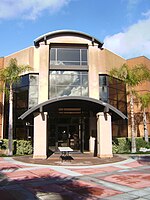San Dimas station
California railway station stubsFuture Los Angeles Metro Rail stationsLos Angeles County, California geography stubsLos Angeles Metro stubsRailway stations scheduled to open in 2025 ... and 2 more
San Dimas, CaliforniaUse mdy dates from November 2023

San Dimas station is an under construction light rail station in the Los Angeles Metro Rail system. The station is located on San Dimas Avenue near its intersection with Bonita Avenue along the Pasadena Subdivision right-of-way in San Dimas, California. It will be served by the A Line. It is currently under construction as part of the Foothill Extension Project and is slated to open in summer 2025.The former Atchison, Topeka and Santa Fe Railway San Dimas Depot is located about 1⁄5 mile (0.32 km) to the northwest and houses the Pacific Railroad Museum. A city-owned 300-space park and ride facility is located adjacent to the facility at 205 S San Dimas Avenue.
Excerpt from the Wikipedia article San Dimas station (License: CC BY-SA 3.0, Authors, Images).San Dimas station
South San Dimas Avenue,
Geographical coordinates (GPS) Address Nearby Places Show on map
Geographical coordinates (GPS)
| Latitude | Longitude |
|---|---|
| N 34.105197 ° | E -117.805967 ° |
Address
CVS Pharmacy
South San Dimas Avenue
91773
California, United States
Open on Google Maps




